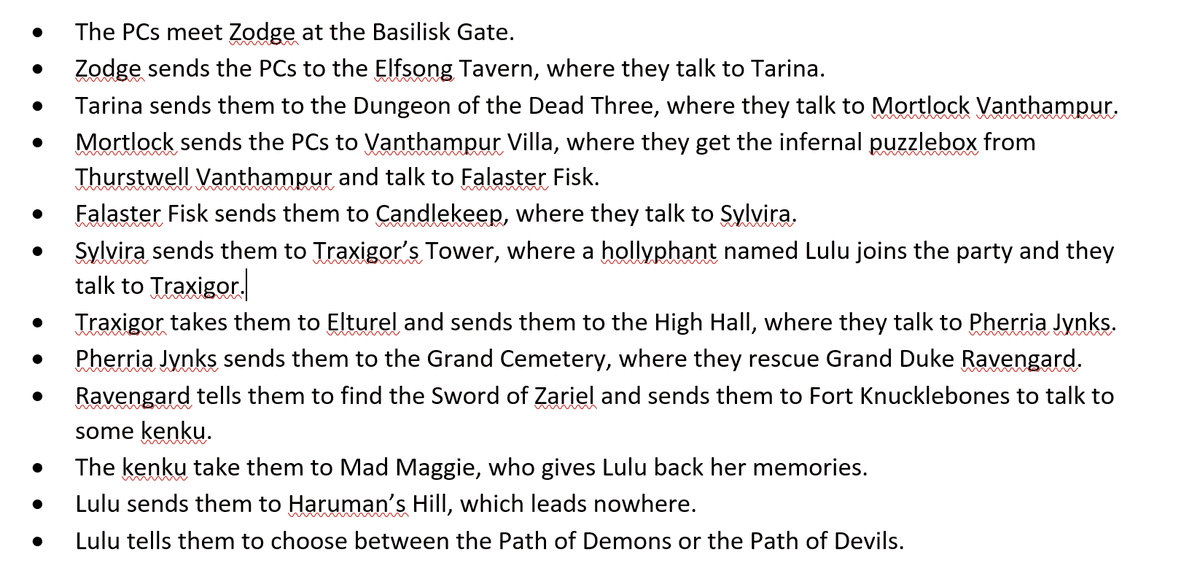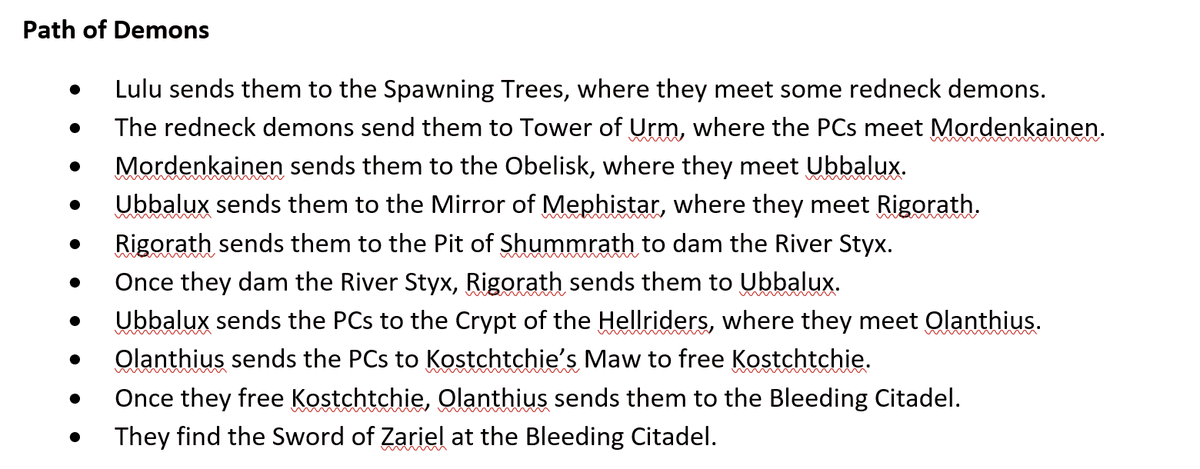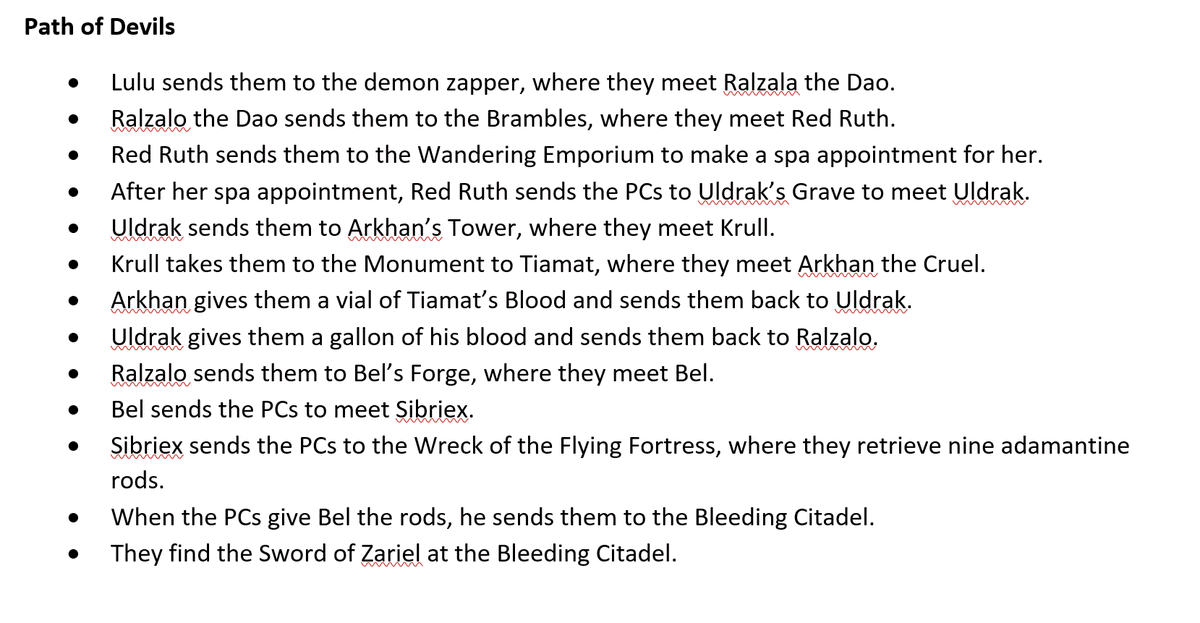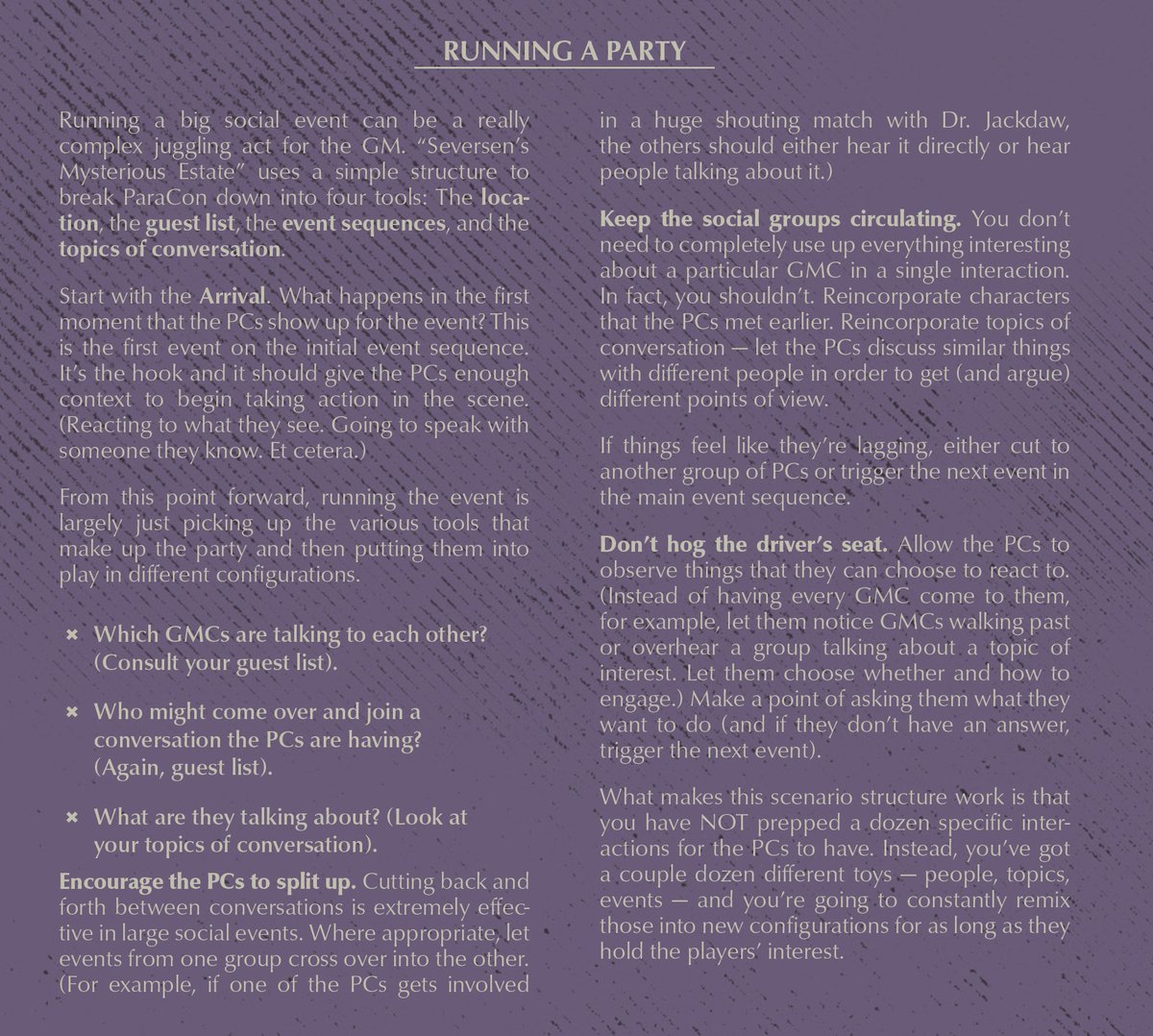My TL is discussing effective formatting for #RPG scenarios today.
IME, we have generally careened between massive walls of undifferentiated text and overly dogmatized straitjackets (that, in the case of the Delve format, also tried to spoonfeed the GM). https://thealexandrian.net/wordpress/1217/roleplaying-games/are-we-really-this-stupid">https://thealexandrian.net/wordpress...
IME, we have generally careened between massive walls of undifferentiated text and overly dogmatized straitjackets (that, in the case of the Delve format, also tried to spoonfeed the GM). https://thealexandrian.net/wordpress/1217/roleplaying-games/are-we-really-this-stupid">https://thealexandrian.net/wordpress...
The first thing is to re-align how we think about adventures. If the writer is thinking of an adventure as a linear plot in which a sequence of specific events need to occur, then: https://thealexandrian.net/wordpress/4147/roleplaying-games/dont-prep-plots">https://thealexandrian.net/wordpress...
1. The adventure structure will be fragile and, thus, unfriendly: Miss any piece of information and the adventure will break.
Good adventure structures have redundancy. A robust adventure structure is more forgiving to the GM missing/forgetting something in play.
Good adventure structures have redundancy. A robust adventure structure is more forgiving to the GM missing/forgetting something in play.
2. No matter what format you proscribe, the writer(s) will be constantly drawn to the idea of hiding information from the reader so that they can reveal the NEXT SHOCKING TWIST(TM).
Why? Because they& #39;re prepping a plot. That& #39;s their mental model of the material, and the model WILL end up on the page.
This is, of course, incredibly unfriendly to the GM: They don& #39;t need to unravel the mystery while running it; they need fast access to accurate information.
This is, of course, incredibly unfriendly to the GM: They don& #39;t need to unravel the mystery while running it; they need fast access to accurate information.
So the second thing we need to do is eschew this scenario-as-fiction model of writing entirely. There should be a comprehensive structural overview of the entire scenario at the very beginning of the scenario. This is both outline and roadmap.
Not only will the GM be able to instantly orient themselves, but this overview should also do most of the heavy lifting in explaining what other stuff in the adventure is supposed to DO.
This will generally streamline the presentation of that material (because you don& #39;t have to spend paragraphs explaining its broader function), which will make it easier to present that material in a clean, friendly manner to the GM.
If it& #39;s a big campaign, you might do this in sections: Here& #39;s the explanation of how these big chunks relate to each other. And then each chunk has a similar structural overview of how that specific chunk works.
This is really simple for a linear adventure. For example, this is what the structure for Descent Into Avernus looks like.
(The other advantage of this is that you can probably quickly spot when your adventure structure is garbage.) https://thealexandrian.net/wordpress/44986/roleplaying-games/remixing-avernus-part-6-the-rest-of-the-remix">https://thealexandrian.net/wordpress...
For a well-designed mystery, you& #39;ll generally be presenting the Revelation List. https://thealexandrian.net/wordpress/40978/roleplaying-games/random-gm-tip-using-revelation-lists">https://thealexandrian.net/wordpress...
For "Seversen& #39;s Mysterious Estate" (a scenario I wrote with Jonathan Tweet for #OverTheEdge in the Welcome to the Island anthology), this meant explaining how to Run a Party.
Now that the GM understands the structure of the adventure, you can think of the rest of the adventure as being a collection of toys in a toybox. Your goal is to make it easy to (a) find the toy you& #39;re looking for and (b) pick up that toy and play with it.
Alot of the stuff I write at the Alexandrian is about how to do this. For example, the Universal NPC Roleplaying Template lets GMs pick up an NPC and immediately start playing them. https://thealexandrian.net/wordpress/37916/roleplaying-games/universal-npc-roleplaying-template">https://thealexandrian.net/wordpress...
The Art of the Key looks at how to structure a location description. https://thealexandrian.net/wordpress/35201/roleplaying-games/the-art-of-the-key-part-2-the-essential-key">https://thealexandrian.net/wordpress...
Adversary rosters organize your "toys" so that they can be easily managed during play. https://thealexandrian.net/wordpress/38547/roleplaying-games/the-art-of-the-key-part-4-adversary-rosters">https://thealexandrian.net/wordpress...
Finally, segregate suggestions and options for HOW the GM can play with particular toys from the description of the toys themselves. Use sidebars and boxouts. https://thealexandrian.net/wordpress/43990/roleplaying-games/design-notes-scenario-tools">https://thealexandrian.net/wordpress...
Also: If we& #39;re talking about a product line, a little forethought can help. Explain common scenario structures you& #39;ll be using in your published adventures in the rulebook & you won& #39;t need to repeat that explanation in every adventure (giving you more space for cool content).
tl;dr
1. Tell the GM how the adventure works.
2. Clear as much muck as possible away from the usable chunks (toys) of your adventure.
3. Sequence the info describing those toys.
Use bold, bullet points, and inline headings to make the sequence/structure/key points clear.
1. Tell the GM how the adventure works.
2. Clear as much muck as possible away from the usable chunks (toys) of your adventure.
3. Sequence the info describing those toys.
Use bold, bullet points, and inline headings to make the sequence/structure/key points clear.

 Read on Twitter
Read on Twitter





